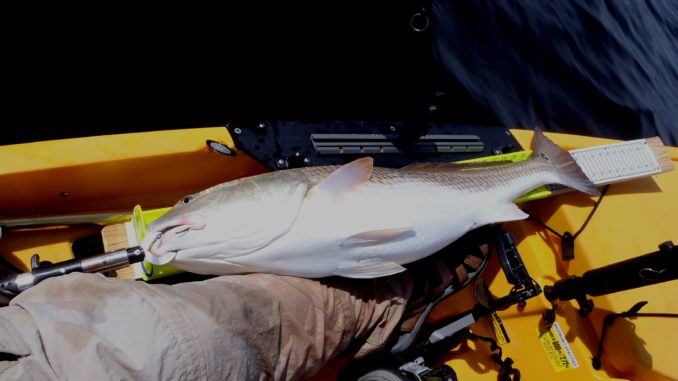
The fall fishery off Oak Island for kings and red drum is a fishery for large fish, some of which must be released. Many fishermen keep king mackerel to eat, and that is good as they are very weak after being fought to a kayak and their odds of healthy survival are not good. On the other hand, red drum may be weak after the fight but have a high survival rate if handled properly and not held out of the water too long for pictures.
The first part of releasing a large fish in good condition is to fight it using heavy enough tackle so it can be landed reasonably quickly and not exhausted. A minimum for these fish should be 20-pound line spooled on an outfit that can handle 5 to 7 pounds of drag. Line testing at 30 pounds is even better; it will easily handle 7 to 10 pounds of drag.
Once a big fish is brought beside the kayak, it is of the utmost importance to handle it in a way that doesn’t injure it. Don’t grab it by the jaw with fish grips or a lip gaff and drag it across the gunwale. This scrapes the protective slime coating off the fish and may bruise internal organs.
The best way to handle big fish is to leave them in the water and pop the hook free there. Since pictures are required to validate the catch, some fish will be handled. Wet your hands and arms and reach under the fish with one arm to support its body, particularly its belly, while lifting it. This helps not remove all the slime, and cradling the body helps prevent damaging internal organs. Lay the fish on a measuring board to get its length.
If you want to weigh the fish, carry a big net and dip the fish into the net. Leave the fish in the net and weigh it in the net, then subtract the weight of the net. Do not hang the fish by its jaw to weigh it; neck and throat tendons and ligaments won’t support the fish’s weight without damage. The successful release and recovery rate is much higher when fish aren’t held vertically by their jaws or gill covers.
The actual release is the final part of a successful release. Ease the fish over the side and hold it beside the kayak with a lip-style gripper. Paddle with one hand or pedal easily to move water across the fish’s gills. Don’t move a fish back and forth in the water to revive it. Fish do not move in reverse and you are actually harming it when you move it backwards.
If you cannot move the kayak forward to move water across a fish’s gills, hold it under the water and move its tail from side to side. This simulates swimming and will suck water across the gills properly. Don’t release the fish the first time it kicks. It will revive better in just a few more seconds and kick harder and more often. Release it then.




Be the first to comment